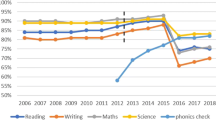Abstract
Simultaneous prompting procedures are infrequently published in the behavior analytic literature yet represent a potential method for promoting nearly errorless learning. No research on simultaneous prompting has targeted early skill repertoires for young children with developmental disabilities. The current study compared simultaneous prompting and constant prompt delay procedures on the acquisition of simple listener responses for a 4-year-old male with Down syndrome. Simultaneous prompting produced responding at mastery levels in less than one third of the total sessions required in the prompt delay condition and substantially fewer errors.



Similar content being viewed by others
References
Brown, A., & Cariveau, T. (2022). A systematic review of simultaneous prompting and prompt delay procedures. Journal of Behavioral Education. Advance online publication.
Cariveau, T., Irwin, C., Moseley, T. K., & Hester, J. (2021). Methods to equate target sets in the adapted alternating treatments design: A review of special education journals. Remedial and Special Education. Advance online publication.
Cengher, M., Budd, A., Farrell, N., & Fienup, D. M. (2018). A review of prompt-fading procedures: Implications for effective and efficient skill acquisition. Journal of Developmental & Physical Disabilities, 30, 155–173. https://doi.org/10.1007/s10882-017-9575-8
Etzel, B. C., & LeBlanc, J. M. (1979). The simplest treatment alternative: The law of parsimony applied to choosing appropriate instructional control and errorless-learning procedures for the difficult-to-teach child. Journal of Autism & Developmental Disorders, 9(4), 361–382. https://doi.org/10.1007/BF01531445
Green, G. (2001). Behavior analytic instruction for learners with autism: Advances in stimulus control technology. Focus On Autism and Other Developmental Disabilities, 16(2), 72–85. https://doi.org/10.1177/108835760101600203
Kodak, T., Campbell, V., Bergmann, S., LeBlanc, B., Kurtz-Nelson, E., Cariveau, T., Haq, S., Zemantic, P., & Mahon, J. (2016). Examination of efficacious, efficient, and socially valid error correction procedures to teach sight words and prepositions to children with autism spectrum disorder. Journal of Applied Behavior Analysis, 49(3), 532–547. https://doi.org/10.1002/jaba.310
Schuster, J. W., Griffen, A. K., & Wolery, M. (1992). Comparison of simultaneous prompting and constant time delay procedures in teaching sight words to elementary students with moderate mental retardation. Journal of Behavioral Education, 2, 305–325. https://doi.org/10.1007/BF00948820
Sindelar, P. T., Rosenberg, M. S., & Wilson, R. J. (1985). An adapted alternating treatments design for instructional research. Education & Treatment of Children, 8(1), 67–76.
Sundberg, M. L. (2008). Verbal behavior milestones assessment and placement program: The VB-MAPP. AVB Press.
Tekin-Iftar, E., Olcay-Gul, S., & Collins, B. C. (2019). Descriptive analysis and meta analysis of studies investigating the effectiveness of simultaneous prompting procedure. Exceptional Children, 85(3), 309–328. https://doi.org/10.1177/0014402918795702
Vom Saal, W., & Jenkins, H. M. (1970). Blocking the development of stimulus control. Learning & Motivation, 1, 52–64.
Funding
This study was not funded.
Author information
Authors and Affiliations
Corresponding author
Ethics declarations
Conflict of Interest
The authors declare that they have no conflict of interest.
Ethical Approval
This study was approved by an Institutional Review Board.
Informed Consent
All participants provided consent before participating in the current study.
Additional information
Publisher’s Note
Springer Nature remains neutral with regard to jurisdictional claims in published maps and institutional affiliations.
The authors wish to thank Katelyn Hunt, Elizabeth Garcia, Jessica Sullivan, and Elizabeth Thuman for their assistance with various aspects of the study.
Rights and permissions
Springer Nature or its licensor (e.g. a society or other partner) holds exclusive rights to this article under a publishing agreement with the author(s) or other rightsholder(s); author self-archiving of the accepted manuscript version of this article is solely governed by the terms of such publishing agreement and applicable law.
About this article
Cite this article
Cariveau, T., Brown, A. Simultaneous Prompting to Teach Initial Listener Responses to a Child with Down Syndrome. Behav Analysis Practice 16, 623–628 (2023). https://doi.org/10.1007/s40617-022-00758-w
Accepted:
Published:
Issue Date:
DOI: https://doi.org/10.1007/s40617-022-00758-w




